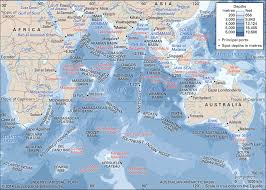The Indian Ocean is the third-largest of the world’s five oceans, covering an area of about 73.56 million square kilometers (28.4 million square miles). It is bordered by several countries and regions:
- To the west: Africa, including countries like South Africa, Kenya, and Somalia.
- To the north: The Middle East and the Indian subcontinent (India, Pakistan, and Sri Lanka).
- To the east: Southeast Asia and Australia.
- To the south: The Southern Ocean, marking the transition to the Antarctic waters.
Key characteristics of the Indian Ocean include:
- Strategic Importance: It is a vital global trade route, connecting the Middle East, Africa, and East Asia with Europe and the Americas. Key shipping routes pass through the Strait of Malacca and the Suez Canal.
- Geography: The ocean is connected to the Pacific Ocean by the Sunda Strait and the Strait of Malacca and to the Atlantic Ocean via the Red Sea and the Gulf of Aden.
- Climate and Weather: The Indian Ocean is known for its monsoon system, which significantly affects the climates of the surrounding countries. The ocean’s surface temperature is relatively warm, influencing weather patterns in neighboring regions.
- Marine Life: The Indian Ocean is home to a wide range of marine species, including fish, whales, and coral reefs. Coral reefs, particularly in regions like the Maldives and the Seychelles, are ecologically important.
- Environmental Concerns: Like many other oceans, the Indian Ocean faces environmental challenges, including overfishing, plastic pollution, and the effects of climate change like rising sea levels and ocean acidification.
The Indian Ocean also has numerous island nations, including the Maldives, Seychelles, Mauritius, and Comoros, and important coastal cities like Mumbai (India), Durban (South Africa), and Singapore.
Is there a specific aspect of the Indian Ocean you’d like to know more about?

